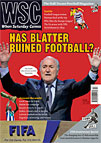 Having survived a brutal beating, one fan is determined to draw attention to Italian police violence. Matthew Barker explains
Having survived a brutal beating, one fan is determined to draw attention to Italian police violence. Matthew Barker explains
On September 24, 2005, Brescia fan Paolo Scaroni was among a group of supporters gathered at Verona’s Porta Nuova train station, preparing to make their way home after a game against the local team, Hellas. Before getting on board, Scaroni went to a nearby McDonald’s to buy a few bottles of water for him and his friends. As he ran back up the steps to the platform he was attacked by a group of eight riot police officers. The beating was so severe that he fell into a coma. It took 20 minutes for medical staff to arrive on the scene then he was operated on at a local hospital.
Doctors warned Scaroni’s parents that he “would be a vegetable”. After two months in a comatose state, the then 28-year-old began to show some signs of recovery, beginning a long period of convalescence. Initially he had no memory of what had happened (and is still unable to recall anything of his life before the assault) but, working with his lawyer, has been able to slowly piece together events.
The police claimed that they had come under attack by the Brescia fans and that attempts were being made to block the train and prevent it from leaving. Scaroni was mentioned, almost in passing, on the last page of their official report of the incident (reference is made to a “seriously injured supporter”), with the implication that he had been the victim of violence at the hands of rival Hellas ultras. However, there were no other sets of supporters in that part of the station. One of the police officers involved then alleged that Scaroni had in fact been beaten up by fellow Brescia fans.
Accusations have been made that members of Scaroni’s family were warned to keep quiet. Police twice asked local authorities in Verona to archive the case (ie let it gather dust and gradually be forgotten about), primarily on the basis that the officers involved could not be recognised on CCTV recordings due to their helmets and protective equipment. Not that there was much footage anyway as cameras mysteriously cut out at the crucial moment.
Both requests were rejected, but the public administrator was highly reluctant to accuse the police of any wrongdoing. Organised supporters’ groups, even those of a relatively non-political hue, have long been demonised, seen as untrustworthy, prone to violence and pretty much fair game in this sort of situation (and this was before the murder of police inspector Filippo Raciti in 2007).
One lone policewoman met Scaroni and decided to take on the case, opening an internal enquiry that eventually led to the establishment of a full court hearing, in March of this year. In the intervening six years Scaroni’s story has been kept in the public eye thanks to the efforts of the ultra group Curva Nord Brescia 1911, who flew banners in his name, staged demonstrations and, earlier this year, produced a beautifully shot documentary to coincide with the beginning of the hearing.
The case is not expected to come anywhere near a conclusion before the autumn. In the meantime Scaroni, now 34, continues to support Brescia, one of the few links he still has with his lost past. “The thing that really upsets me is that they’ve cancelled out my childhood and adolescence. I’ve lost all memories of my first 20 years of existence.”
Scaroni has spoken recently of establishing some sort of national association for the victims of police violence. A close bond has been formed with the father of Gabriele Sandri, the Lazio fan killed by a police officer in November 2007, and the family of Federico Aldrovandi, the 18-year-old who was beaten to death by police in Ferrara on the very same night Scaroni was attacked. The parallels between the three events are obvious but, as he points out: “There’s one crucial difference: I can still tell my story.”
Clips from the documentary can be viewed at www.brescia1911curvanord.net
From WSC 293 July 2011